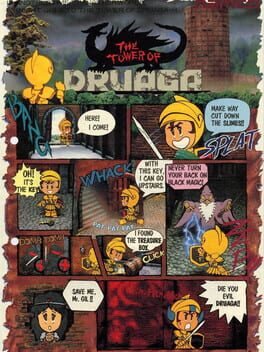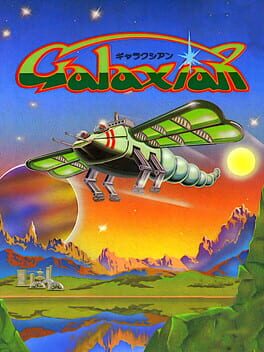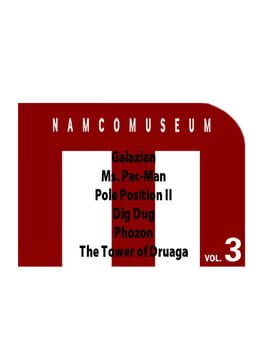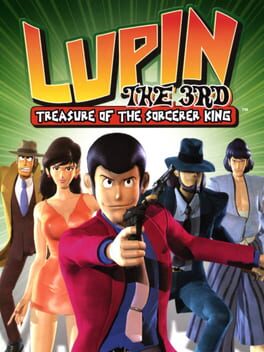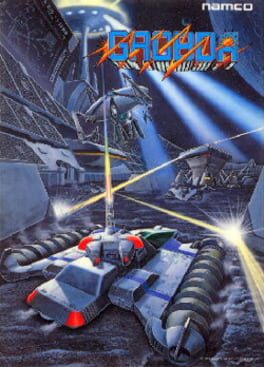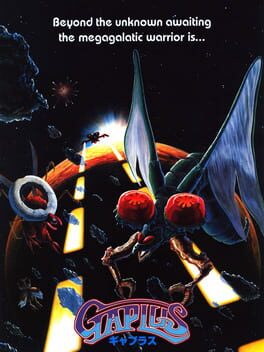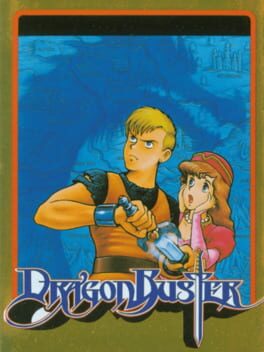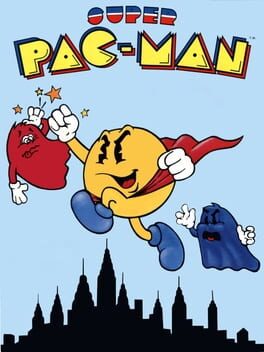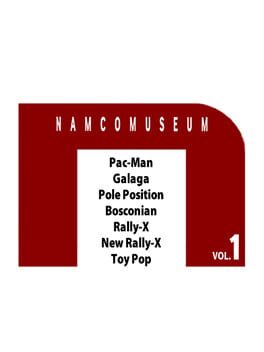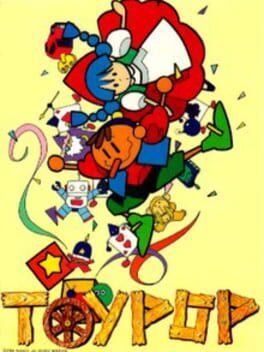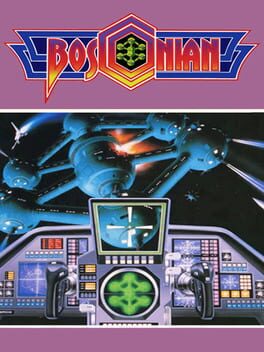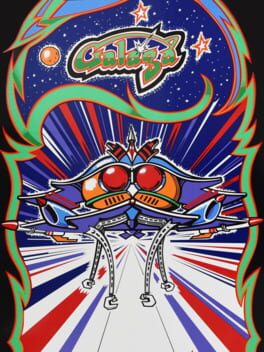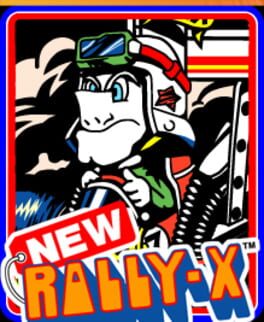BansheeNeet
BACKER
1984
Very historically important, and the way players in Japan collaborated in order to collectively figure out all the dungeon's secrets is something I love learning more about, but there's no getting around that it's not very fun to just play on your own with no plan or context going in. I'm content with just hearing other people talk about it. Ki is good though, I'm all about Ki.
1979
Having a better understanding of the Invaders boom in Japan, and after actually giving it a fair shake rather than just disregard it as "slow Galaga", I've come to appreciate this game more than the first time I encountered it. It's basically Space Invaders with a little more excitement, and it's fun. It has the same fun of finding the best shot timing and positioning possible, just with some layers liking dodging incoming enemies and the "escort" bonus when it comes to the enemies at the top of the swarm. Just a nice time, that's all.
1996
With the second volume of Namco Museum having the exact same "museum layer" presentation, I was totally ready for 3 to be the same, so it was quite a surprise to find that the presentation here has been totally revamped for the better! First of all, everything takes much less time to load, and the game isn't throwing you into a loading screen every time you want to look at a low res image of an arcade pamphlet. This makes the "exhibits" something I would actually want to stop and look at, rather than disregard it as a waste of time. I also feel like the rooms that the games are in are much more animated and ambitious, like the Galaxian room having a whole light sequence as you enter it that goes along with the music, or the Ms. Pac-Man room having the titular Ms. and her dog dancing while Pac-Man shits in the toilet. The aforementioned exhibits are also now more closely themed to the game they lead into rather than being the same format each time.
The devs could've just used the same template on all of these volumes and been just fine, but the fact they bothered to revamp it for the better is really cool, and shows a dedication to make sure these games are well presented with the treatment they deserve. In terms of the games here, it's a pretty good line-up all things considered. Ms. Pac Man and Dig Dug alone could carry any collection of classic games, but this volume takes some time to acknowledge games that, while not the most fun taken out of their historical context, are important enough that I'm glad they were put here. While Galaxian will always be seen as only the precursor to Galaga, I came to appreciate it a lot more here than in other collections, it's a decently fun take on Space Invaders, and it's interesting to see how this formula eventually evolved into Galaga and more advanced shmups in the future. The Tower of Druaga is also a very important game, especially to Japanese game history, but I still can't really get much out of it here. It's legacy has more to do with the collaborative effort that arcade-goers made to "solve" the game and it's many mysteries, so maybe someday I want to look into how to get further in it, but I think I prefer learning about it than playing it. Pole Position II is more Pole Position, and Phozon is a strange on that I still don't fully have my head around. It's a very respectable line-up, and that combined with the changes in presentation make this possibly the best entry so far, or at least neck-and-neck with 1. It also really speaks to the wide range of themes, settings, and genres that Namco was experimenting with in the arcades. 4 and 5's game lists seem to be really out there, so I'm excited to be pushed out of my comfort zone when it comes to classic Namco.
Let me also take the time to express my appreciation for something that's been in every entry but I keep forgetting to mention: I love that they let you see the way these games boot up, with an overload of sprites blasting the screen for a couple seconds. It always looks cool, and I feel like most collections would shy away from something that looks so "messy", so the fact they've left these in since the first volume is greatly appreciated. It's a tiny piece of history that they wisely preserved.
The devs could've just used the same template on all of these volumes and been just fine, but the fact they bothered to revamp it for the better is really cool, and shows a dedication to make sure these games are well presented with the treatment they deserve. In terms of the games here, it's a pretty good line-up all things considered. Ms. Pac Man and Dig Dug alone could carry any collection of classic games, but this volume takes some time to acknowledge games that, while not the most fun taken out of their historical context, are important enough that I'm glad they were put here. While Galaxian will always be seen as only the precursor to Galaga, I came to appreciate it a lot more here than in other collections, it's a decently fun take on Space Invaders, and it's interesting to see how this formula eventually evolved into Galaga and more advanced shmups in the future. The Tower of Druaga is also a very important game, especially to Japanese game history, but I still can't really get much out of it here. It's legacy has more to do with the collaborative effort that arcade-goers made to "solve" the game and it's many mysteries, so maybe someday I want to look into how to get further in it, but I think I prefer learning about it than playing it. Pole Position II is more Pole Position, and Phozon is a strange on that I still don't fully have my head around. It's a very respectable line-up, and that combined with the changes in presentation make this possibly the best entry so far, or at least neck-and-neck with 1. It also really speaks to the wide range of themes, settings, and genres that Namco was experimenting with in the arcades. 4 and 5's game lists seem to be really out there, so I'm excited to be pushed out of my comfort zone when it comes to classic Namco.
Let me also take the time to express my appreciation for something that's been in every entry but I keep forgetting to mention: I love that they let you see the way these games boot up, with an overload of sprites blasting the screen for a couple seconds. It always looks cool, and I feel like most collections would shy away from something that looks so "messy", so the fact they've left these in since the first volume is greatly appreciated. It's a tiny piece of history that they wisely preserved.
After several sessions of attempting to get further in this and then putting it down out of frustration over the stealth mechanics, I just have to give up. Adapts so much of the style and charm of Lupin's characters so well (the sequence that let's you play as Goemon was the highlight for me) but it's idea of challenging stealth is making you stop and salute every cop on screen every 3 seconds if you want to not immediately get sussed out. The challenge of each area becomes the fact that getting from point A to point B is always a hassle, and my strategy eventually devolved into "run through this room full of guards, hit them all with a frying pan if needed, then find an empty room to lower your suspicion level in by waiting and doing nothing." It does so much of what I wish game adaptations of anime would do, but then it's also just a bad game.
1984
1984
Honestly a really cool follow-up to Galaga, one I would more fond of if it weren't also really hard. I'm not great at these games, but I definitely get wiped out a lot earlier here than in Galaga. But in terms of graphical improvements and new mechanics like giving the player their own tractor beam, really impressive.
1985
I have no idea how any of the shit in this game works. I just sort of jumped and slashed at bosses until I got a game over, but I did manage to get fairly far with this tactic so I don't know. Would love to find someone who can sit me down and tell me how to make actual progress here, except not really because I don't care that much.
1982
I've tried to see the good in this game but I honestly can't stand it. It's like a Pac-Man version of 52 pick-up, there's shit on the floor everywhere and picking it all up isn't fun. Just doesn't carry any of fun spirit of the original, and what it tries to replace it with feels like nonsense. I just get mad when I think about keys, and the Super Power Pellet, and gates, and the ghosts being dumber in this because the maze is set up like shit, and Super Power Pellet combined with Normal Power Pellet, and the Super Button, and the random slot machine bonus, and the worse music, stop it!! Enough with this tomfoolery!!
1996
Has basically the exact same presentation and structure of the first volume, which I already reviewed, so it comes down to the quality of game selection. On one hand, Super Pac-Man is here to ruin the day for everyone, but on the other hand, Mappy is here to save it. I'm fond of Xevious aesthetically, but can't really get far in it, Gaplus is really cool but I'm also bad at that, Dragon Buster is inscrutable, and Grobda. Overall, not as good of a list of games but still carries the charm of the second.
Also, I had no idea these games has a run button until playing this one. I always just assumed you had to walk slow because its rude to run in a museum, but things work a little differently in this museum...
Also, I had no idea these games has a run button until playing this one. I always just assumed you had to walk slow because its rude to run in a museum, but things work a little differently in this museum...
2023
Definitely a thing where they came up with the idea of having a sleep tracking app first and then had to sloppily build a game around that idea. Mechanics are just sort of thrown at you, with no attempt at telling you why you should bother doing any of this besides "maybe we'll tell you if you sleep funny after all this busy work". Also, this game has some glitch with me where the sound doesn't work if I don't have headphones, and for some reason that results in the alarm being comically quiet, so it can't even do the basic function of waking me up. Chikorita was there, that was nice I guess.
1995
Video game museums are beautiful places. I'm just now having this epiphany that I love being in museums in video games. I'm thinking about certain parts of the Radiohead Kid Amnesiac experience, the museum section of Sonic Mega Collection, Animal Crossing museums, the trophy gallery in Melee, Bubsy Visit the James Turrell Retrospective, all these things are very different but are what I would consider to be vital video game museums. And in that list, near the top, is the titular Namco Museum.
So Namco Museum games have been on basically every console since the PS1, and if you've played any entry besides the PS1 games, you wouldn't realize that at some point there was an actual "museum" to this so-called "Namco Museum". It's not just a catchy name for a collection of old games, it was an actual virtual location to walk around and observe exhibits in. You play as Pac-Man, as indicated by the adorable Pac-Man sprite in the bottom left corner that walks when you walk and goes "!" when he notices something you can click on. After giving a nice robot attendant your 3-letter name, you begin to wander the halls of the (relatively small) museum, featuring 6 main exhibits dedicated to the games on this entry in the series and a lounge dedicated to extras. The calm and atmospheric music, the PS1 textured marble tiles and columns, it's perfect video game museum vibes, and, tragically, this feature never made it outside of these initial entries. There's an option for if you want to just get straight to the game, you can just immediately start playing Pac-Man if you'd like, but I'm the kind of person who would much rather walk slowly to Pac-Man after going through the Pac-Man exhibit and observing several pieces of Pac-Man paraphernalia.
As for the game selection itself, obviously, you want to open with Pac-Man and Galaga, that's a no-brainer. But other all-timers like Dig Dug and Ms.Pac-Man are left out, not to be seen until later entries in the PS1 Namco Museum collection, in a move that is absolutely motivated by getting you to buy more than one of these games, but I think Namco makes up for this tactic by having this entry include two games that most people wouldn't recognize: Toypop and Bosconian. These are not only obscure entries but also just plain fun games, so including them in the first volume was a great idea. It sets the ground rules of these games: A little bit of the classics, and a little bit of the deep cuts, all treated with the same amount of historical importance. And Pole Position is there, say hi to Pole Position for me I guess.
Now obviously, this game, and this series on the PS1 in general, is not the ideal way to play any of these games. You can only play them with a d-pad, they don't emulate sound perfectly, and they take a hit lag-wise. And the museum aspect itself has some problems, like every image and piece of an exhibit taking around 5 seconds or so to load, which ends up discouraging you from checking out every piece of the museum if you value your time. But despite these problems, the vibes win out in the end. I haven't even mentioned the fantastical rooms that each game resides in. After going through little bits and details of each game, you go through a door that transports you out of the museum and into another world, much like these games did for the people who played them. Each of these rooms also has an incredible arrangement of their respective game's theme, made even more impressive considering most of them didn't have much music to work off of. No matter their problems, these games might be worth it just for these arrangements alone.
As someone who is very intrigued by Namco's classic arcade line-up and also someone who loves going through a virtual exhibit, I cannot wait to go through the rest of this series. I know this is not the ideal way to experience these games, except they are, because they're in a cool ps1 museum. Who needs accuracy when you have vibes?
So Namco Museum games have been on basically every console since the PS1, and if you've played any entry besides the PS1 games, you wouldn't realize that at some point there was an actual "museum" to this so-called "Namco Museum". It's not just a catchy name for a collection of old games, it was an actual virtual location to walk around and observe exhibits in. You play as Pac-Man, as indicated by the adorable Pac-Man sprite in the bottom left corner that walks when you walk and goes "!" when he notices something you can click on. After giving a nice robot attendant your 3-letter name, you begin to wander the halls of the (relatively small) museum, featuring 6 main exhibits dedicated to the games on this entry in the series and a lounge dedicated to extras. The calm and atmospheric music, the PS1 textured marble tiles and columns, it's perfect video game museum vibes, and, tragically, this feature never made it outside of these initial entries. There's an option for if you want to just get straight to the game, you can just immediately start playing Pac-Man if you'd like, but I'm the kind of person who would much rather walk slowly to Pac-Man after going through the Pac-Man exhibit and observing several pieces of Pac-Man paraphernalia.
As for the game selection itself, obviously, you want to open with Pac-Man and Galaga, that's a no-brainer. But other all-timers like Dig Dug and Ms.Pac-Man are left out, not to be seen until later entries in the PS1 Namco Museum collection, in a move that is absolutely motivated by getting you to buy more than one of these games, but I think Namco makes up for this tactic by having this entry include two games that most people wouldn't recognize: Toypop and Bosconian. These are not only obscure entries but also just plain fun games, so including them in the first volume was a great idea. It sets the ground rules of these games: A little bit of the classics, and a little bit of the deep cuts, all treated with the same amount of historical importance. And Pole Position is there, say hi to Pole Position for me I guess.
Now obviously, this game, and this series on the PS1 in general, is not the ideal way to play any of these games. You can only play them with a d-pad, they don't emulate sound perfectly, and they take a hit lag-wise. And the museum aspect itself has some problems, like every image and piece of an exhibit taking around 5 seconds or so to load, which ends up discouraging you from checking out every piece of the museum if you value your time. But despite these problems, the vibes win out in the end. I haven't even mentioned the fantastical rooms that each game resides in. After going through little bits and details of each game, you go through a door that transports you out of the museum and into another world, much like these games did for the people who played them. Each of these rooms also has an incredible arrangement of their respective game's theme, made even more impressive considering most of them didn't have much music to work off of. No matter their problems, these games might be worth it just for these arrangements alone.
As someone who is very intrigued by Namco's classic arcade line-up and also someone who loves going through a virtual exhibit, I cannot wait to go through the rest of this series. I know this is not the ideal way to experience these games, except they are, because they're in a cool ps1 museum. Who needs accuracy when you have vibes?
1986
Has a surprising amount of depth for what it is. Going for the room clear bonus involves carefully maneuvering around enemies and power-ups as you have to use the appropriate weapon for each enemy, which makes the mechanic of getting random items from presents a lot more important than how it first seems. There's a lot to like here, but I still wasn't necessarily motivated to seek out more than what I've seen. To be fair I played the Namco Museum PS1 version, which I can definitely tell isn't the most up to snuff version of this game. Two player would probably be fun, and also way easier, possibly too easy? Someone on here with friends let me know what it's like.
1981
Love the title "Bosconian". A great entry in the tradition of "space shooters that put together some cool sounding syllables to evoke some kind of Alien Thing". The game itself is pretty neat too. Not really much to it, but having two bullets come out when you shoot, one forward and one behind, is really smart, and helps keep the game from feeling too aggressive, even though enemy fire is pretty relentless. It's an entire game centered around blowing up death stars, and that's neat.
1981
1981
Have come to appreciate this game much more after playing the original Rally-X and realizing that this is such a better game that the original is basically rendered pointless. The game starts off much more forgiving, it has actual music, and it has the L flag, a really good way to rack up points by finding it as early in a round as possible. The rival cars still feel a little too fast, as even with the radar it's very easy to be completely caught off guard by one of them. Despite that, the changes from the original Rally-X even make failure more fun, as you feel like you can get a lot more done with every life, rather than being doomed to go back and forth between the same two points in the map trying not to get cornered by three cars. This is a game I could actually see myself putting the time into getting good at.
